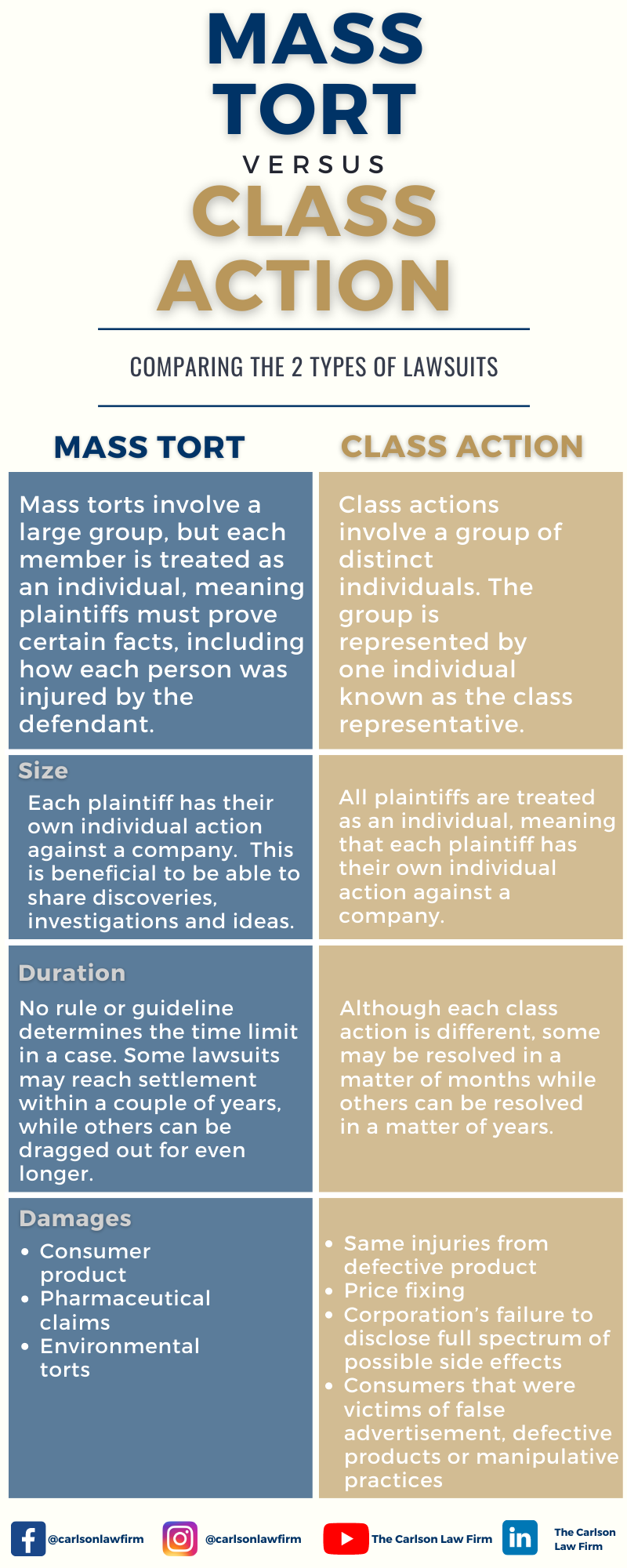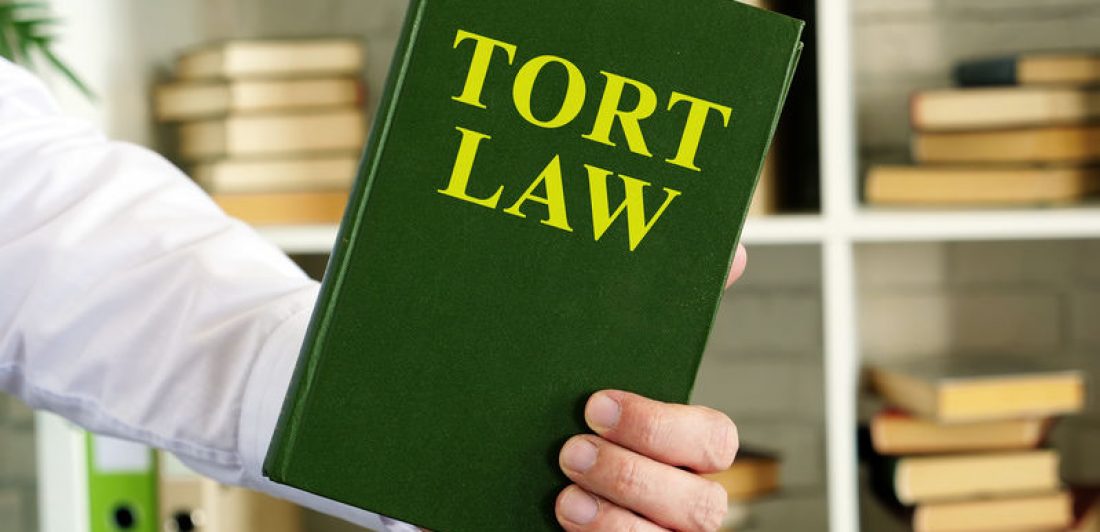Nearly everyone who has left their TV on overnight is familiar with the legal term class-action lawsuit. But many don’t understand that there is another lesser-known term called a mass tort. While a mass tort and class action deal with a group of people that have been wronged by a single negligent defendant, they differ in how your attorney approaches the case and often have different outcomes.
What are the Similarities Between a Class Action and a Mass Tort?
In the most common lawsuits, there is usually one person or “plaintiff” seeking compensation for damages. However, for mass torts and class action lawsuits, the “plaintiff” is made up of hundreds or thousands of people that have suffered injuries from the actions of a common defendant. Often, these two types of lawsuits are confused with one another since both aims to decrease the number of court cases with similar facts. Because of this, the two types of proceedings share the following similarities:
- Composed of a large group going after the same defendant.
- Consolidated into one action.
Grouping complaints is often done to reduce the number of cases that come up with the same problem.
What is a Mass Tort?
A mass tort is when an attorney brings multiple lawsuits against a defendant or a group of defendants simultaneously. What sets torts apart from class action is in mass tort injuries vary in severity which leads to differing award amounts based on the nature of the person’s injury. As a result, the recovery in mass tort claims is much higher than in a class action.
Generally, a tort refers to an act or omission of one party that causes harm or injury to another through negligence. A mass tort is a civil action that involves several plaintiffs with varying degrees of injuries from the negligent actions of one or more defendants. In a mass tort, each plaintiff has their own individual action against a company.
Because of the similarities in each lawsuit, these cases often proceed by being grouped as multidistrict litigation (MDL). This consolidation reduces the number of court cases brought by individuals and places all of the cases before a single judge in one court. The goal of an MDL is to save time and resources for all parties involved.
In a mass tort, attorneys can apply their investigative findings, expert testimony, and other resources to all claims.
These cases are related to some form of negligence with most of the cases being:
- Consumer product
- Pharmaceutical claims
- Environmental torts or man-made catastrophes, such as hurricanes, fires, explosions, or floods.
What to Expect in a Mass Tort?
At the beginning of the case, the attorney must ask the court if the victims have permission to file a large mass tort. When deciding whether or not to allow a mass tort, a court may consider the following:
- How many individuals are involved in the suit
- The proximity of the individuals
- The injuries that the plaintiffs suffered and whether they are similar
- Whether the claims that the plaintiffs filed were associated with a common cause
The benefits of being active in a mass tort case are that you have the opportunity to share discoveries, investigations, and ideas about navigating the pre-trial process with the other plaintiffs. Additionally, mass tort actions bring attention to negligent behavior and can act as a deterrent for continued negligence or stop other companies from making similar mistakes.
Mass tort cases can be very complex, but having a lawyer by your side to assist in your case can be very beneficial to holding big companies accountable. If you have realized that you may have a mass tort case, contact our office today to discuss your potential legal rights.
What is a Class Action?
A class action is when an attorney brings one lawsuit on behalf of a group of clients. Unlike a mass tort where award amounts differ based on varying injuries, in a class action, plaintiffs all suffer the same injury and thus award amounts are the same. For example, a class action against Red Bull alleged that customers who purchased Red Bull did not get the concentration and energy boost advertised in their marketing. In conclusion, any unsatisfied customer received a $10 check or voucher for $15 worth of Red Bull products.
As demonstrated above, class actions typically provide relief to a large number of consumers that were wronged by a corporation and lost a small monetary amount. In these cases, compensation usually isn’t enough to be beneficial for each plaintiff to hire an individual lawyer.
Class actions can arise for a number of reasons, including the following:
- Injuries from the same defective product
- Price fixing
- A corporation’s failure to disclose the full spectrum of possible side effects
- Consumers that were victims of false advertisement, defective products, or manipulative practices
If the attorney believes that there is a class action case, then he or she will draft a complaint. The complaint will describe who may be covered by the lawsuit. The class can either be on a state or a nationwide level.
In order for a claim to be considered a class action suit to the court, specific characteristics and certain criteria must be met. The court will certify the case if:
- There’s a legal claim against the defendant;
- A large group of people who have similar damages and side effects from the same product;
- The main plaintiff and attorneys have a plan that represents the class members appropriately.
There is a reasonable plan that the lead plaintiff and attorney draft that represents the class members appropriately.
Once the criteria is met, the attorney may:
- Find out how many people may have been injured the same way
- Find out if there is a lawsuit that has the same allegation already filed
- Determine if the individual still has time to file a claim
- Research previous rulings to determine
- Determine if the individual may file an independent suit instead of a class action
In a class action, all affected participants will have the chance to accept to be added to the class or find their own representative. As mentioned earlier, the motion must be filed in a court to evaluate the facts of the case and determine whether it can be filed.
The number of people that suffered the same or similar injuries can get together by combining their lawsuit and the value will increase.
 What are the Differences Between a Class Action and Mass Tort?
What are the Differences Between a Class Action and Mass Tort?
The difference is the treatment that the group receives. Usually, the number of individuals involved in a mass tort case tends to be less than a large class action. Each member in a mass tort is treated as an individual and must establish the facts to prove the damages done by the defendant. Although all plaintiffs involved in the case might have similar damages done to them, they will all have to prove what were the damages done to them specifically, since not everyone was affected the same way. This includes serious injury, such as medical bills, emotional and physical suffering, and lost wages. The monetary issue justifies the reason why it would be appropriate to proceed with a mass tort since financial remuneration is based on the extent of each individual’s injury.
In a class suit, all of the members in the large group are considered a class and are represented by a class representative. All of the members will be treated as one plaintiff since they all must’ve suffered the same kind of negligence or damage. Therefore, it’s better to have one trial.
However, it is important to know which one is the best option to go after. For example, if the litigation includes any medical records, it will be tricky to have a class suit since there will be multiple records to go through and all are different reasons. In this case, the best way to go would be to file a mass tort case.
The Carlson Law Firm is the team you need
The Carlson Law Firm is a national mass torts law firm that believes that one person can make a difference. Your story matters, even if you are the lone voice against a powerful industry, such as drug manufacturers o another ginormous company. Our experienced team of mass torts attorneys is available to help clients nationwide.
At the end of the day, mass torts and class actions seek justice from business owners, individuals, and companies that might be too powerful for just one individual to fight alone. If you or someone that you know needs help to build a mass tort suit, contact our offices for a free consultation with one of our attorneys. Mass torts may be hard to figure out where to start, but with the help of one of our mass tort experts, we can help alleviate any stress that you may have.




